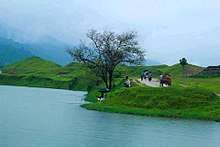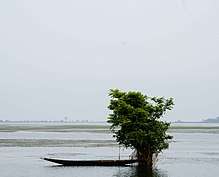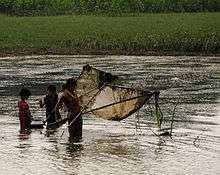Tanguar Haor
Tanguar haor (Bengali: টাঙ্গুয়ার হাওর, Sylheti: ꠐꠣꠋꠉꠥꠀꠞ ꠀꠅꠞ; also called Tangua haor), located in the Dharmapasha and Tahirpur upazilas of Sunamganj District in Bangladesh, is a unique wetland ecosystem of national importance and has come into international focus. The area of Tanguar haor including 46 villages within the haor is about 100 square kilometres (39 sq mi) of which 2,802.36 ha2 is wetland. It is the source of livelihood for more than 40,000 people. The Government of Bangladesh declared Tanguar haor as an Ecologically Critical Area in 1999 considering its critical condition as a result of overexploitation of its natural resources. In 2000, the hoar basin was declared a Ramsar site - wetland of international importance. With this declaration, the Government is committed to preserve its natural resources and has taken several steps for protection of this wetland.
| Designations | |
|---|---|
| Official name | Tanguar Haor |
| Designated | 10 June 2000 |
| Reference no. | 1031[1] |



Tanguar haor plays an important role in fish production as it functions as a 'mother fishery' for the country[2][3]
Every winter the haor is home to about 200 types of migratory birds. The haor is an important source of fish. In 1999–2000, the government earned 7,073,184 takas as revenue just from fisheries of the haor. There are more than 140 species of fresh water fish in the haor. The more predominant among them are: ayir, gang magur, baim, tara, gutum, gulsha, tengra, titna, garia, beti, kakia etc. Gulli, balua, ban tulsi, nalkhagra and other freshwater wetland trees are in this haor.[3]
Plant species like Hizol (Barringtonia acutangula), Clematis cadmia, Crataeva nurvala, Euryale ferox, Nelumbo nucifera, Ottelia alismoides, Oxystelma secamone var. secamone, Pongamia pinnata, Rosa clinophylla, and Typha species are present.
See also
| Wikimedia Commons has media related to Tanguar haor. |
References
- "Tanguar Haor". Ramsar Sites Information Service. Retrieved 2018-04-25.
- "Tanguar Haor". IUCN Bangladesh. Archived from the original on 2007-11-14. Retrieved 2007-11-23.
- Talukdar, Nixon (2012). "Tanguar Haor". In Islam, Sirajul; Jamal, Ahmed A. (eds.). Banglapedia: National Encyclopedia of Bangladesh (Second ed.). Asiatic Society of Bangladesh.